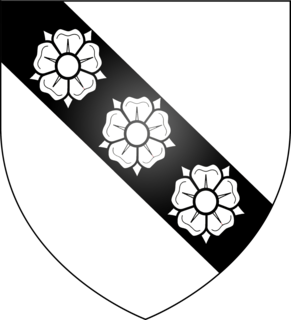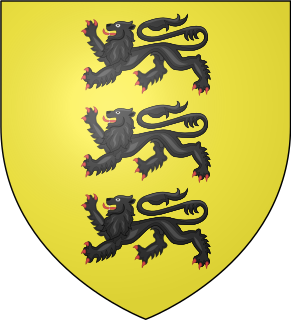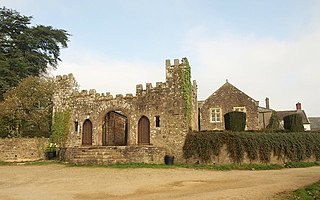
Sir William Huddesfield (died 1499) of Shillingford St George in Devon, was Attorney-General to Kings Edward IV (1461–1483) [1] and Henry VII (1485–1509). [2] He built the tower of St George's Church, Shillingford. [3]

Sir William Huddesfield (died 1499) of Shillingford St George in Devon, was Attorney-General to Kings Edward IV (1461–1483) [1] and Henry VII (1485–1509). [2] He built the tower of St George's Church, Shillingford. [3]
He was the son of William Huddesfield of Shillingford by his wife Alice Gold, daughter of John Gold (alias Gould) of Seaborough and Sampit [4] in Dorchester, MP for Dorchester in 1391, [5] and was the grandson of William Huddesfield of Honiton, Devon. [6] [7]

Seaborough is a small village and civil parish in the county of Dorset in southwest England. It is sited in the valley of the River Axe and lies approximately 2 miles (3.2 km) south of Crewkerne in Somerset. The parish was previously part of the hundred of Crewkerne, but was transferred to within Dorset in 1896. In 2013 the estimated population of the civil parish was 60.

Dorchester is the county town of Dorset, England. It is situated between Poole and Bridport on the A35 trunk route. A historic market town, Dorchester is on the banks of the River Frome to the south of the Dorset Downs and north of the South Dorset Ridgeway that separates the area from Weymouth, 7 miles (11 km) to the south.
Dorchester was a parliamentary constituency centred on the town of Dorchester in Dorset. It returned two Members of Parliament to the House of Commons of the Parliament of the United Kingdom from 1295 to 1868, when its representation was reduced one member.

He married twice:
Firstly to Jennet [9] (or Elizabeth [10] ) Bosome, daughter and heiress of John Bosome (alias Bosom, Bozun, Bosum, etc.) of Bosom's Hele, in the parish of Dittisham, Devon, [11] and widow of Sir Baldwin de Fulford (died 1476) [12] of Great Fulford in the parish of Dunsford, Devon, Sheriff of Devon in 1460, a Knight of the Sepulchre and Under-Admiral to John Holland, 2nd Duke of Exeter (died 1447), High Admiral of England. [13] By Jennet Bosome he had one daughter, according to Pole (died 1635): [14]

Dittisham is a village and civil parish in the South Hams district of the English county of Devon. It is situated on the west bank of the tidal River Dart, some 2 miles (3.2 km) upstream of Dartmouth.

Great Fulford is an historic estate in the parish of Dunsford, Devon. The grade I listed manor house, known as Great Fulford House, is about 9 miles west of Exeter. Its site was said in 1810 to be "probably the most antient in the county". The present mansion house is Tudor with refurbishment from the late 17th century and further remodelling from about 1800. The prefix "Great" dates from the late 17th century and served to distinguish it from the mansion house known as "Little Fulford" in the parish of Shobrooke, Devon, about 8 miles to the north-east, also owned briefly by Col. Francis Fulford (1666–1700), as a result of his marriage to the heiress of the Tuckfield family. Great Fulford has been the residence of the Fulford family, which took its name from the estate, from the reign of King Richard I (1189–1199) to the present day. There are thus few, if any, families in Devonshire of more ancient recorded origin still resident at their original seat. In 2004 the estate comprised 3,000 acres.

Dunsford is a village in Devon, England, just inside the Dartmoor National Park.

Mohuns Ottery or Mohun's Ottery, is a house and historic manor in the parish of Luppitt, 1 mile south-east of the village of Luppitt and 4 miles north-east of Honiton in east Devon, England. From the 14th to the 16th centuries it was a seat of the Carew family. Several manorial court rolls survive at the Somerset Heritage Centre, Taunton, Somerset.

Luppitt is a village and civil parish in East Devon situated about 6 kilometres (4 mi) due north of Honiton.

Thérouanne is a commune in the Pas-de-Calais department in the Hauts-de-France region of France. It is located 10 km (6.2 mi) west of Aire-sur-la-Lys and 13 km (8.1 mi) south of Saint-Omer, on the D 157 and D 341 road junction. Located on the river Lys.
Secondly (as her third husband) to Katherine Courtenay (died 1514), [19] a daughter of Sir Philip Courtenay (died 1463) [20] of Powderham, Devon, by his wife Elizabeth Hungerford, daughter of Walter Hungerford, 1st Baron Hungerford (died 1449), and sister of Peter Courtenay (died 1492) Bishop of Exeter and of Sir Philip Courtenay (b.1445) of Molland, MP and Sheriff of Devon in 1471. [21] She requested in her will to be buried in the Greyfriars Church, Exeter "before St Francis beside the High Altar", but was probably buried at Shillingford with her husband. [22] A monumental brass of Huddesfield and his second wife Katherine Courtenay survives in Shillingford St George Church. [23] His sister-in-law Phillipa Courtenay married his step-son Sir Thomas Fulford (died 1489), the eldest son and heir of Sir Baldwin de Fulford (died 1476) [24] by his first wife Jane Bosome [25] By his second wife Katherine Courtenay he had one daughter, according to Pole: [26]

Sir Philip Courtenay of Powderham, Devon, was the senior member of a junior branch of the powerful Courtenay family, Earls of Devon.
Powderham is a former manor on the coast of south Devon, England, situated within the historic hundred of Exminster, about 6 miles (9.7 km) south of the city of Exeter and adjacent to the north-east of the village of Kenton. It consists in part of flat, formerly marshy ground on the west bank of the River Exe estuary where it is joined by its tributary the River Kenn, the site of Powderham Castle, originally the fortified manor house of Powderham. On the opposite side of the Exe is the small village of Lympstone and almost opposite is Nutwell Court in the parish of Woodbury, formerly the castle or fortified manor house of the powerful mediaeval Dynham family.

Walter Hungerford, 1st Baron Hungerford KG was an English knight and landowner, from 1400 to 1414 Member of the House of Commons, of which he became Speaker, then was an Admiral and peer.

Sir Anthony Poyntz was an English diplomat and naval commander.

Iron Acton is a village, civil parish and former manor in South Gloucestershire, England. The village is about 2 miles (3 km) west of Yate and about 9 miles (14 km) northeast of the centre of Bristol. The B4058 road used to pass through the village but now by-passes it just to the north.
He died on 20 March 1499, and was buried in Shillingford St George's Church, where his chest tomb survives against the north chancel wall.

A monumental brass of Huddesfield and his second wife Katherine Courtenay survives in Shillingford St George Church, [28] and the arms of Bosome (Azure, three bird bolts in pale points downward or) survive in a stained glass window in the same church. [29] The brass is affixed to the wall on the north side of the chancel, above a chest tomb, with grey marble slab on top, set into an Easter Sepulchre style alcove remade in the 19th century. [30] Around the edge of the slab is an ident for an inscription in brass, now lost, but transcribed in 1630 by the Devon historian Thomas Westcote (c. 1567 – c. 1637) as follows: [31]
The brass depicts a knight and a lady, both kneeling under a double canopy, with a son and two daughters. The bare headed knight is fully dressed in armour, over which he wears a tabard showing the arms of Huddesfield with a crescent for difference, with sword and spurs. in front of him is a prie dieu, on which is an open book, and his gauntlets are on the floor by his side, with his helmet on top of which is his crest, a boar rampant. The lady wears a pedimental head-dress and lappets, with gown, ornamented girdle with pomander hanging therefrom. Over all she wears a robe of estate showing the arms of Courtenay: Or, three torteaux a label of three points azure. Behind her kneels her only son by her second husband George Rogers, and behind him her two daughters Elizabeth and Katherine. The following inscription, partly in Latin, appears below (with abbreviations extended):
A framed rubbing of the brass hangs in the chapel of Powderham Castle.

The Cary family is an English aristocratic family with a branch in Ireland. The earliest known ancestor of the family is Sir Adam de Kari who was living in 1198. Sir John Cary purchased the Manor of Clovelly in the 14th century and established the family's status as members of the landed gentry. Various branches of the family were ennobled in the late 16th and early 17th centuries as Baron Hunsdon and Viscount Falkland.

The Courtenay family of Tremere was a cadet line of the prominent Courtenay family seated at Powderham in Devon, itself a cadet line of the Courtenay Earls of Devon of Tiverton Castle, feudal barons of Plympton and feudal barons of Okehampton.

William Courtenay, 1st Earl of Devon, feudal baron of Okehampton and feudal baron of Plympton, was a member of the leading noble family of Devon. His principal seat was Tiverton Castle, Devon with further residences at Okehampton Castle and Colcombe Castle, also in that county.

Haccombe is a hamlet, former parish and historic manor in Devon, situated 2 1/2 miles east of Newton Abbot, in the south of the county. It is possibly the smallest parish in England, and was said in 1810 to be remarkable for containing only two inhabited houses, namely the manor house known as Haccombe House and the parsonage. Haccombe House is a "nondescript Georgian structure" (Pevsner), rebuilt shortly before 1795 by the Carew family on the site of an important mediaeval manor house.

Edward Courtenay, 1st Earl of Devon, KG was an English nobleman. He was a member of the ancient Courtenay family.

Sir John Carew, 3rd Baronet of Antony, Cornwall, was an English politician who sat in the House of Commons variously between 1660 and 1692.

Sir John Chichester (1519/20-1569) of Raleigh in the parish of Pilton, near Barnstaple in North Devon, was a leading member of the Devonshire gentry, a naval captain, and ardent Protestant who served as Sheriff of Devon in 1550-1551, and as Knight of the Shire for Devon in 1547, April 1554, and 1563, and as Member of Parliament for Barnstaple in 1559, over which borough his lordship of the manor of Raleigh had considerable influence.

John Wrey of North Russell, Sourton, and Bridestowe in Devon and Trebeigh, St Ive, Cornwall, was Sheriff of Cornwall in 1587.

Sir William Wrey, 1st Baronet of Trebeigh, St Ive, Cornwall and North Russell, Sourton, Devon, was High Sheriff of Cornwall in 1598 and was created a baronet by King Charles I in 1628.

Upcott is an historic manor in the parish of Cheriton Fitzpaine, Devon. The manor house, known as Upcott Barton is a mediaeval grade II* listed building notorious in the history of Devon as the place where in 1455 occurred the murder of the lawyer Nicholas Radford by a mob directed by the Earl of Devon during the Wars of the Roses. In the grounds is a reproduction of an Iron Age roundhouse built circa 2014.

Dowrich is an historic estate in the parish of Sandford, on the River Creedy, three miles north-east of Crediton in Devon, England. Between the 12th century and 1717 it was the seat of the ancient gentry family of Dowrish which took its name from the estate where it had become established before the reign of King John (1199–1216), when it built a castle keep on the site. A 15th century gatehouse survives there today, next to the ancient mansion house.

Sir John Chichester lord of the manor of Raleigh in the parish of Pilton, near Barnstaple, North Devon, was Sheriff of Devon in 1576/7 and/or in 1585 and died of gaol fever contracted whilst acting as a magistrate at the Lent Black Assizes of Exeter in 1586.

Sir John Kirkham (1472–1529) of Blagdon in the parish of Paignton, Devon, was Sheriff of Devon in 1523/4. He was one of the Worthies of Devon of the Devonshire biographer Prince (d.1723), who called him a "very free and liberal, ... prudent and discreet" benefactor of the town of Honiton in Devon.
The manor of Modbury was a manor covering the ecclesiastical parish of Modbury in Devon. The manor house, last occupied by the Champernowne family and known as "Court House", was situated on the north side of the parish church of St George, on or near the site of Modbury Priory, founded in the 12th century by the Vautort lords of the manor. It was destroyed during the Civil War (1642–1651) and the remnants were sold for building materials in 1705.